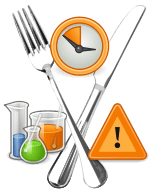FAT TOM
 | |
| Terms | |
|---|---|
| Foodborne illness | |
| Hazard analysis and critical control points (HACCP) • Hazard analysis and risk-based preventive controls (HARPC) | |
| Critical control point | |
| Critical factors | |
| FAT TOM | |
| pH | |
| Water activity (aw) | |
| Bacterial pathogens | |
| Clostridium botulinum | |
| Escherichia coli | |
| Listeria | |
| Salmonella | |
| Vibrio cholerae | |
| Viral pathogens | |
| Enterovirus | |
| Hepatitis A | |
| Norovirus | |
| Rotavirus | |
| Parasitic pathogens | |
| Cryptosporidium | |
| Entamoeba histolytica | |
| Giardia | |
| Trichinella | |
FAT TOM is a mnemonic device used in the food service industry to describe the six favorable conditions required for the growth of foodborne pathogens. It is an acronym for food, acidity, time, temperature, oxygen and moisture.[1]
Conditions
Each of the six conditions that foster the growth foodborne pathogens are defined in set ranges:[2]
| F | Food | There are sufficient nutrients available that promote the growth of microorganisms. Protein-rich foods, such as meat, milk, eggs and fish are most susceptible. |
| A | Acidity | Foodborne pathogens require a slightly acidic pH level of 4.6-7.5, while they thrive in conditions with a pH of 6.6-7.5. The United States Food and Drug Administration's (FDA) regulations for acid/acidified foods require that the food be brought to pH 4.5 or below. |
| T | Time | Food should be removed from "the danger zone" (see below) within two-four hours, either by cooling or heating. While most guidelines state two hours, a few indicate four hours is still safe. |
| T | Temperature | Food-borne pathogens grow best in temperatures between 41 to 135 °F (5 to 57 °C), a range referred to as the temperature danger zone (TDZ). They thrive in temperatures that are between 70 to 104 °F (21 to 40 °C).[3] |
| O | Oxygen | Almost all foodborne pathogens are aerobic, that is requiring oxygen to grow. Some pathogens, such as Clostridium botulinum, the source of botulism, are anaerobic. |
| M | Moisture | Water is essential for the growth of foodborne pathogens, water activity (aw) is a measure of the water available for use and is measured on a scale of 0 to 1.0. Foodborne pathogens grow best in foods that have aw between 0.95 and 1.0. FDA regulations for canned foods require aw of 0.85 or below. |
References
- ↑ Servsafe Essentials Fifth Edition. 2008. p. 27. ISBN 978-1-58280-224-4.
- ↑ "Food safety lessons: FAT TOM". Iowa State University, University Extension school.
- ↑ ""Danger Zone" (40 °F - 140 °F)". US Department of Agriculture. Retrieved 14 October 2015.
See also
This article is issued from Wikipedia - version of the 10/9/2016. The text is available under the Creative Commons Attribution/Share Alike but additional terms may apply for the media files.